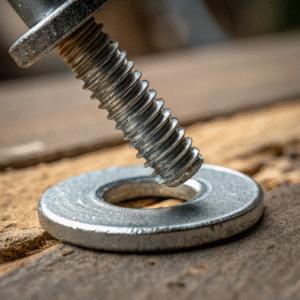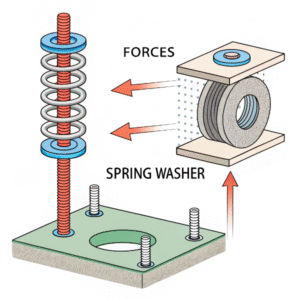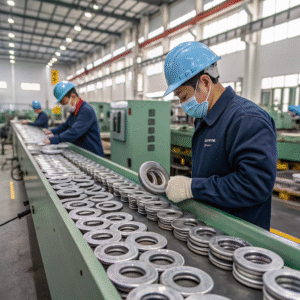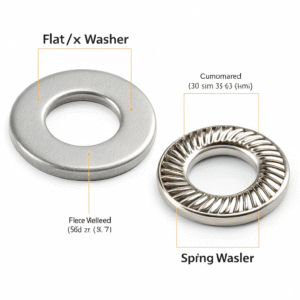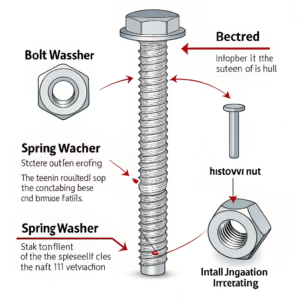
How Does a Spring Washer Actually Prevent Loosening?
Are your bolted joints failing under vibration? This constant worry about reliability can compromise safety. Understanding how a simple spring washer works is key to preventing catastrophic failures in your designs.
A spring washer prevents loosening by using its built-in elasticity to exert a continuous axial force on the fastener. This force increases the friction between the threads and under the nut, creating resistance against a bolt or nut unscrewing due to vibration or thermal cycling.
For an engineer like Sarah, who designs heavy machinery, every component matters. A loose bolt isn’t just an inconvenience; it can lead to equipment failure, downtime, and serious safety risks. We often rely on small parts like washers to ensure the integrity of our larger designs. But do you really understand the mechanics behind how they work? It’s not just a piece of metal. It’s a precisely engineered component with a critical job. Getting to the bottom of how it performs its function will help you make better design and sourcing decisions, ensuring every joint you specify is as secure as possible. Let’s explore the details.
What’s the Real Mechanism Behind a Spring Washer’s Grip?
You see the split in the washer and assume it just "digs in." This common oversimplification can lead you to use them incorrectly, putting your designs at risk without you even realizing it.
The real mechanism isn’t just about biting into the metal. It’s about leveraging the washer’s engineered spring force to maintain tension, known as preload, in the bolted joint. This is what truly provides the locking function and keeps your assemblies secure under stress.
When I first started in this industry over 15 years ago, I thought spring washers worked by creating a physical lock. But the more we tested them, the more I understood the physics. The core principle is based on elastic deformation and force balance. When you tighten a nut, you are compressing the spring washer, flattening its helical shape. The metal’s memory, or its elasticity, makes it want to return to its original shape. This desire to "spring back" creates a constant pushing force against the nut and the joint surface.
The Science of Preload and Friction
This constant pushing force is critical. It maintains the preload—the tension in the bolt itself. In a high-vibration environment, a standard nut can slowly work itself loose as tiny movements overcome the static friction in the threads. The spring washer counteracts this. It acts like a tiny, stiff suspension system, absorbing micro-movements and ensuring the clamping force remains high. This sustained force creates much greater friction, making it significantly harder for the nut to rotate and loosen. It’s a simple but incredibly effective principle of active resistance.
| Joint Condition | Without Spring Washer | With Spring Washer |
|---|---|---|
| Initial State | Bolt is tensioned, creating preload. | Bolt is tensioned, and washer is compressed. |
| Under Vibration | Micro-slips can reduce tension, leading to loosening. | Spring force actively maintains tension, resisting loosening. |
| Result | Higher risk of joint failure over time. | Greatly increased resistance to vibrational loosening. |
Is a Spring Washer Just a Bent Piece of Metal?
It’s easy to look at a spring washer and dismiss it as a simple, low-tech commodity. But this thinking leads to sourcing cheap, low-quality parts that ultimately fail when you need them most.
A true spring washer is not just a piece of metal; it is a precisely engineered spring. Its material composition, heat treatment, and geometry are all carefully controlled to deliver a specific and reliable clamping force, ensuring the safety and durability of your final product.
A spring washer is a purpose-built mechanical spring. Its job is to provide a specific amount of force when compressed to a certain height. To achieve this reliably, every step of its creation is critical. I remember a case where a client’s equipment was failing field tests due to joint loosening. They sent us their components, and we discovered the spring washers they were using were made from untreated steel. After one tightening cycle, they became just flat, useless rings with no "spring" left in them. They were just bent pieces of metal, not functional springs.
From Raw Material to Reliable Spring
The journey starts with the right material. We typically use high-carbon spring steel, like 65Mn, or specific grades of stainless steel that have excellent elastic properties. After the washer is formed, it undergoes a critical heat treatment process. This involves quenching and tempering to achieve a very specific hardness. If it’s too soft, it will permanently deform under load (what we call "taking a set"). If it’s too hard, it becomes brittle and can crack under pressure. For an engineer like Sarah, receiving parts with consistent hardness and full material traceability is non-negotiable, because that is the foundation of the washer’s locking performance.
| Key Characteristic | Material | Required Property | Why It’s Important |
|---|---|---|---|
| Elasticity | High-Carbon Spring Steel (e.g., 65Mn) | Ability to return to original shape | This is what creates the locking spring force. |
| Hardness | Heat-Treated to ~40-50 HRC | Resistance to permanent deformation | Ensures the washer can be used and reused without losing its clamping ability. |
| Toughness | Tempered Steel | Resistance to fracture | Prevents the washer from cracking under the high stress of a tightened bolt. |
When Should You Use a Plain Washer Versus a Spring Washer?
You see a flat washer and a spring washer in the parts bin. They look similar, but choosing the wrong one for your application can be a critical design mistake that goes unnoticed until it’s too late.
Using a flat washer when you need vibration resistance provides a false sense of security. Knowing the distinct purpose of each—load distribution versus active locking—is fundamental to designing a secure and durable bolted joint that performs as intended.
The most common point of confusion I see with new engineers is when to use a flat washer and when to use a spring washer. The answer lies in their fundamentally different jobs. A flat washer is a passive component. Its main role is to act as a smooth, strong spacer. A spring washer, on the other hand, is an active component. Its job is to fight against the forces trying to loosen the joint. Think of it this way: a flat washer is like the foundation of a house—it spreads the load. A spring washer is like the house’s shock absorbers—it actively responds to external forces.
Load Distribution vs. Active Locking
You use a plain, flat washer for three primary reasons: to distribute the pressure of the nut or bolt head over a wider surface area, to span an oversized or slotted hole, or to provide a smooth bearing surface for the nut to turn against. This is especially important when fastening into softer materials like aluminum or composites, as it prevents the fastener from digging in and damaging the surface. A spring washer does the opposite. Its split, sharp edges are designed to bite into the bearing surface and the underside of the nut slightly, adding another layer of rotational resistance on top of the preload force it generates. Using one where you just need to protect a soft surface is a mistake.
| Feature | Plain (Flat) Washer | Spring Washer |
|---|---|---|
| Primary Function | Load Distribution, Surface Protection | Anti-loosening, Tension Maintenance |
| Shape | Solid, flat, continuous ring | Split, helical ring with sharp edges |
| Mechanism | Passive: Increases the bearing surface area. | Active: Exerts a continuous spring force. |
| Ideal Use Case | On soft materials, with oversized holes. | In environments with high vibration or thermal cycles. |
| Risk if Misused | Does not prevent vibrational loosening. | Can damage soft component surfaces. |
What is the Correct Way to Install a Spring Washer?
You’ve selected the perfect, high-quality spring washer for your application. But installing it in the wrong order can make it completely useless, or even create an unstable joint that’s worse than having no washer at all.
There is a standard, correct assembly sequence that ensures the spring washer’s locking force is applied correctly. The spring washer must always be placed directly against the component that turns—usually the nut—to do its job effectively.
This might sound like a very basic detail, but in our factory, it’s one of the first things we teach new technicians. We can produce the highest-quality lock washer in the world, meeting every specification for hardness and material, but if the end user installs it incorrectly, all that engineering effort is wasted. The logic is simple, but crucial for the washer to function.
The Logic of the Fastener Stack
The purpose of the spring washer is to stop the nut (or sometimes the bolt head) from rotating loose. Therefore, its locking force must be applied directly to that component. The correct sequence is for the spring washer to be placed between the nut and the main joint surface. As the nut is tightened, the spring washer is compressed and its edges press into both the underside of the nut and the surface below it. This creates the resistance needed. A common mistake is placing a flat washer between the spring washer and the nut. This allows the nut to turn smoothly on the flat washer’s surface, completely defeating the locking function.
The standard stack-up is:
- Bolt Head
- Workpiece / Components
- Spring Washer (Directly against the nut)
- Nut
If you are fastening into a soft material like aluminum, you might want to protect its surface. In that specific case, you would place a flat washer against the workpiece first, then the spring washer, then the nut. The flat washer protects the surface, and the spring washer still acts on the nut.
Conclusion
Spring washers use engineered elastic force to maintain bolt tension and prevent loosening. Correctly selecting the right type and installing it properly is vital for any secure, vibration-resistant assembly.
Share this article
About the Author
[email protected]
Experienced professional in manufacturing and industrial solutions with over 15 years of expertise in fasteners and precision components.
Table of Contents
Related Topics
You may also be interested in:

Sourcing from China? 6 Hallmarks of a World-Class OEM Fastener Manufacturer
In the global indust
